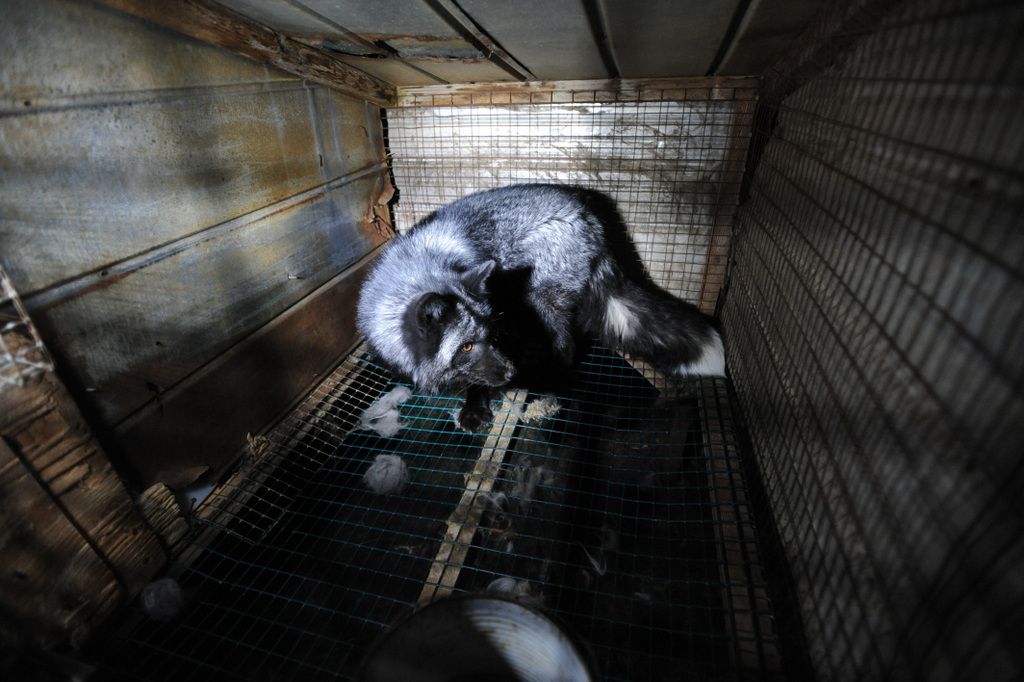Two animal protection groups have begun a new national campaign to end the confinement and slaughter of millions of animals every year to support Canada’s fur industry.
The #MakeFurHistory campaign was started by The Association for the Protection of Fur-Bearing Animals (APFA) and The Montreal Society for the Prevention of Cruelty to Animals (SPCA) with the support of LUSH Cosmetics.
Photo courtesty of The Association for the Protection of Fur-Bearing Animals (APFA)
“Shocking footage” from Canadian fur farms was released on October 30th by APFA as part of the new consumer awareness campaign.
“Over the last several months, The Association for the Protection of Fur-Bearing Animals has obtained this footage from a number of farms across the country,” said Adrian Nelson, Director of Communications for APFA.
“It goes without saying that no compassionate Canadian politician would stand by if dogs were forced into these conditions; yet through inaction and complacency, they have accepted this as the reality for millions of fox and mink every year.”
According to APFA, it is estimated that there are over 200 fur farms in Canada. Animals, including fox, mink, raccoon dogs, and rabbits are kept in tiny bare cages — often only large enough for them to turn around.
“These conditions go against the very nature of these creatures, and as a result, injuries and maladies are common, including broken bones, broken teeth, internal bleeding, severe infections and more — all accepted by industry as they do not damage the fur,” said APFA in their release.
“Due to the confined quarters, other behaviours that are abnormal appear, including cannibalism. The best way to stop this kind of inherently inhumane practice is to say no to fur. Though most fur-bearing animals killed for their skin in Canada are exported overseas, we can still make a difference as informed consumers.”
According to APFA, over 100,000,000 animals are killed for their fur every year worldwide.
APFA said independent, nationally and world-renowned academic and professional experts in wildlife, animal behavior and veterinary medicine reviewed the video footage obtained at fur farms across Canada, with a specific focus on the conditions in which they animals are housed — typical mink and fox cages used in fur farms throughout North America.
“Minks are solitary semiaquatic animals with large territories to roam,” said Stefan Harsch, DMV.
“Besides filthy water bowls there is no access to a water source in a way these animals can live their natural behaviors. Confinement in such small wire cages in close proximity to other animals and the denial of any enrichment in the enclosure causes significant stress and leads to the pathologic behavior patterns observed in the video.
Stereotypic behaviors like continuously circling and jumping up the cage wall, biting the wires are a clear sign of stress and suffering. The filthy environment with decomposing feces piled under and even inside the cages adds another level of stress to these confined animals.”
In the wild, “mink spend up to 60 per cent of their time in the water, have a home range of 5km and are extremely territorial,” said APFA.
“On an industrial fur farm, mink spend their entire lives in cages measuring 1′ by 3′, never have the chance to swim, and live crammed up against hundreds — even thousands — of other animals.
Fox, raccoon dogs, rabbits and other fur-bearing animals kept on fur farms are highly social animals who never get a taste of freedom they are born craving.
The environmental damage caused by fur factory farms is different in every region, but rarely are there appropriate controls to protect ecosystems.
In Canada, no federal legislation regulates the raising of animals on fur farms or the trapping of wild animals for fur.”
“The horrific conditions of the animals’ physical environment and apparent state of health are unacceptable,” said Dr. Sherri Cox, Wildlife Veterinarian. “Basic food and water alone do not mean that humane treatment and acceptable conditions exist.”
“The video footage overall appears consistent with the general practices that I observed on a BC fur farm in summer 2014,” said Sara Dubois, PhD. “There are no fox farms in the province, and thus my observational experience is limited to mink farming.”
In 2012, according to Statistics Canada, Canadian fur farms saw 8,540 fox and 2,971,200 mink born. Of that number, 8,120 foxes and 2,804,800 mink were killed and their pelts harvested.
“Whether it’s fur from industrial factory farms or animals trapped in the wild, fur for fashion is unnecessary and always cruel,” said Nelson, Director of Communications for APFA.
“Together, Canadians can end this inherently inhumane industry. Together, we can #MakeFurHistory.”




